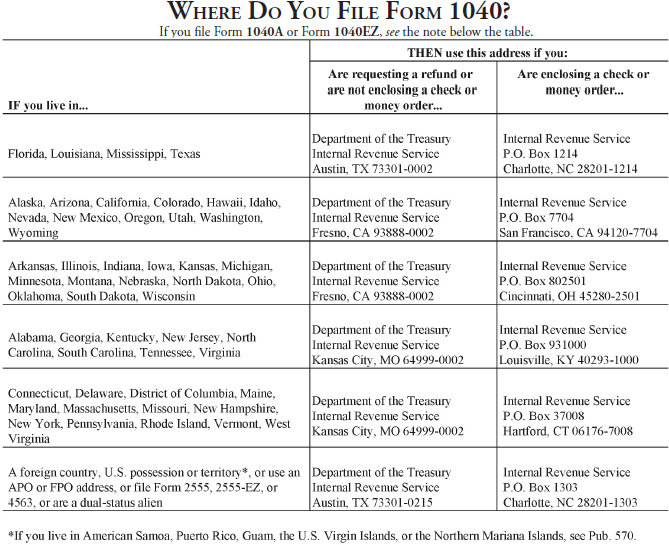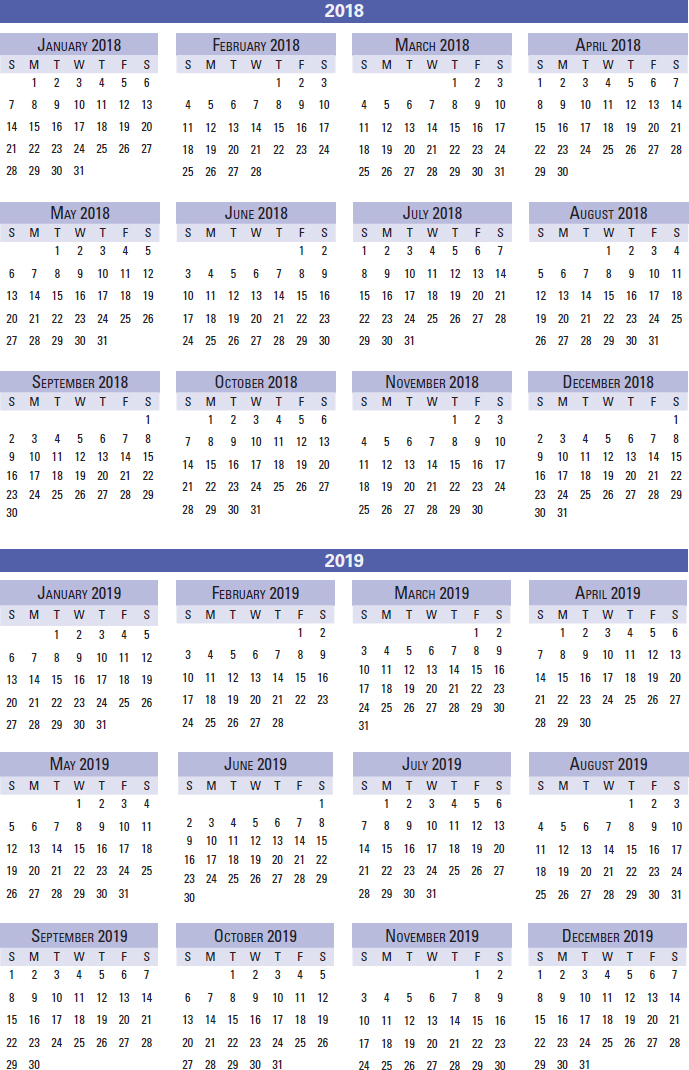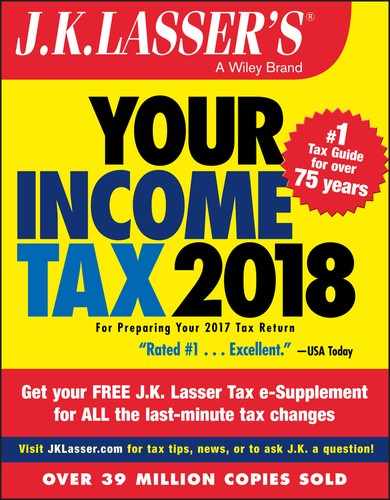Part 1
Filing Basics
In this part, you will learn these income tax basics:
- Whether you must file a return
- When and where to file your return
- Which tax form to file
- What filing status you qualify for
- When filing separately is an advantage for married persons
- How to qualify as head of household
- How filing rules for resident aliens and nonresident aliens differ
- How to claim personal exemption deductions for yourself, your spouse, and your dependents.
Do You Have to File a 2017 Tax Return?
| If you are— | You must file if gross income for 2017 is at least |
| Single | |
| Under age 65 | $ 10,400 |
| Age 65 or older on or before January 1, 2018 | 11,950 |
| Married and living together at the end of 2017 | |
| Filing a joint return—both spouses under age 65 | 20,800 |
| Filing a joint return—one spouse age 65 or older on or before January 1, 2018 | 22,050 |
| Filing a joint return—both spouses age 65 or older on or before January 1, 2018 | 23,300 |
| Filing a separate return (any age) | 4,050 |
| Married and living apart at the end of 2017 | |
| Filing a joint or separate return | 4,050 |
| Head of a household maintained for a child or other relative (1.12) | |
| Under age 65 | 13,400 |
| Age 65 or older on or before January 1, 2018 | 14,950 |
| Widowed in 2015 or 2016 and have a dependent child (1.11) | |
| Under age 65 | 16,750 |
| Age 65 or older on or before January 1, 2018 | 18,000 |
Marital status. For 2017 returns, marital status is generally determined as of December 31, 2017. Thus, if you were divorced or legally separated during 2017, you are not considered married for 2017 tax purposes, and you must use the filing threshold for single persons unless you qualify as a head of household (1.12), or you remarried in 2017 and are filing a joint return with your new spouse.
If your spouse died in 2017 and you were living together on the date of death, use the filing threshold shown for married persons living together at the end of 2017. If you were not living together on the date of death, the $4,050 filing threshold applies, unless you remarried during 2017 and are filing jointly with your new spouse.
Same-sex marriages. Lawfully married same-sex couples are treated as married for all federal tax purposes. The IRS recognizes your marriage to a same-sex spouse if the marriage was legally entered into in one of the 50 States, the District of Columbia, Puerto Rico, U.S. territory or possession, or foreign country (1.1).
Age 65. Whether you are age 65 or older is generally determined as of the end of the year, but if your 65th birthday is on January 1, 2018, you are treated as being age 65 at the end of 2017.
Gross income. Gross income is generally all the income that you received in 2017, except for items specifically exempt from tax.
Include wages and tips(Chapter 2), self-employment income(Chapter 45), taxable scholarships(Chapter 33), taxable interest and dividends(Chapter 4), capital gains(Chapter 5), taxable pensions and annuities(Chapter 7), rents(Chapter 9), and trust distributions(Chapter 11). Home sale proceeds that are tax free(Chapter 29) and tax-free foreign earned income(Chapter 36)are considered gross income for purposes of the filing test.
Exclude tax-exempt interest(Chapter 4), tax-free fringe benefits(Chapter 3), qualifying scholarships(Chapter 33), and life insurance(Chapter 11). Also exclude Social Security benefitsunless (1)you are married filing separately and you lived with your spouse at any time during 2017, or (2) 50% of net Social Security benefits plus other gross income and any tax-exempt interest exceeds $25,000 ($32,000 if married filing jointly). If 1 or 2 applies, the taxable part of Social Security benefits as determined in(34.3) is included in your gross income.
Other situations when you must file. Even if you are not required to file under the gross income tests, you must file a 2017 return if:
- You are self-employed and you owe self-employment tax because your net self-employment earnings for 2017 are $400 or more (Chapter 45), or
- You (or your spouse if filing jointly) received HSA or Archer MSA distributions (Chapter 41), or
- You are entitled to a refund of taxes withheld from your wages (Chapter 26) or a refund based on any of these credits: the premium tax credit, the earned income credit for working families ,the additional child tax credit (Chapter 25), or the American Opportunity credit (Chapter 38), or
- You owe any special tax such as alternative minimum tax (Chapter 23), the Additional Medicare Tax or the Net Investment Income Tax (Chapter 28), IRA penalties (Chapter 8), household employment taxes (Chapter 38), and FICA on tips (Chapter 26), or
- You received advance payments of the premium tax credit (25.12), or you owe the individual responsibility penalty (38.5).
Filing Tests for Dependents: 2017 Returns
The income threshold for filing a tax return is generally lower for an individual who may be claimed as a dependent than for a nondependent. You are a “dependent” if you are the qualifying child or qualifying relative of another taxpayer, and the other tests for dependents at (21.1) are met. If you are the parent of a dependent child who had only investment income subject to the “kiddie tax” (24.3), you may elect to report the child’s income on your own return for 2017 instead of filing a separate return for the child; see(24.4) for the election rules.
If, under the tests at (21.1), you may be claimed as a dependent by someone else, use the chart below to determine if you must file a 2017 return. Include as unearned income taxable interest and dividends, capital gains, pensions, annuities, unemployment compensation, taxable Social Security benefits, and distributions of unearned income from a trust. Earned income includes wages, tips, self-employment income, and taxable scholarships or fellowships (Chapter 33). Gross income is the total of unearned and earned income.
For married dependents, the filing requirements in the chart assume that the dependent is filing a separate return and not a joint return (Chapter 1). Generally, a married person who files a joint return may not be claimed as a dependent by a third party who provides support.
For purposes of the following chart, a person is treated as being age 65 (or older) if his or her 65th birthday is on or before January 1, 2018. Blindness is determined as of December 31, 2017.
Where to File Your 2017 Return
If you filed a paper federal tax return for 2016 and also are filing a paper federal return for 2017, check your 2017 tax form instructions to see if the IRS filing address for your residence has changed. The table below may not reflect late IRS changes. Changes to the table will be in the e-Supplement at jklasser.com.
When you file, include your complete return address and if you are enclosing numerous attachments with your return, make sure that you include enough postage.

Filing Form 1040A or 1040EZ? If you live in any of the 50 states or the District of Columbia, and are not enclosing a payment with your Form 1040A or 1040EZ, you can use the address shown above for Form 1040 (middle column) except you must change the last four digits of the zip code. The last four digits of the zip code for Form 1040A are 0015 and for Form 1040EZ they are 0014, instead of 0002 for Form 1040.
If you are enclosing a check or money order with your Form 1040A or 1040EZ, then, regardless of where you live, use the same IRS address and zip code as shown above for Form 1040 in the right column of the table.
Also use the same address and zip code shown for Form 1040, whether or not you are enclosing a payment, if you live in a foreign country, U.S. possession or territory, use an APO or FPO address, file Form 2555, 2555-EZ, or 4563, or you are a dual-status alien.
Filing Deadlines (on or before)
January 16, 2018 —. Pay the balance of your 2017 estimated tax. If you do not meet this date, you may avoid an estimated tax penalty for the last quarter by filing your 2017 return and paying the balance due by January 31, 2018.
Farmers and fishermen: File your single 2017 estimated tax payment by January 16, 2018. If you do not, you may still avoid an estimated tax penalty by filing a final tax return and paying the full tax by March 1, 2018.
January 31, 2018 —. Make sure you have received a Form W-2 from each employer for whom you worked in 2017.
April 17, 2018 —. April 15, 2018, falls on a Sunday, and Emancipation Day, a legal holiday in the District of Columbia, falls on Monday, April 16, 2018. As a result, you have until Tuesday, April 17, 2018, to file your 2017 return and pay the balance of your 2017 tax liability.
If you cannot meet the April 17 deadline for your 2017 return, you may obtain an automatic six-month filing extension to October 15 by filing Form 4868 (electronically or on paper). However, even if you get an extension, interest will still be charged for taxes not paid by the original April 17 deadline and late payment penalties will be imposed unless at least 90% of your tax liability is paid by the original deadline or you otherwise show reasonable cause. If you cannot pay the full amount of tax you owe when you file your return, you can file Form 9465 to request an installment payment arrangement.
If on the April 17 deadline you are a U.S. citizen or resident living and working outside the U.S. or Puerto Rico, or in military service outside the U.S. or Puerto Rico, you have an automatic two-month filing extension until June 15, 2018.
Pay the first installment of your 2018 estimated tax on or before this date.
June 15, 2018 —. Pay the second installment of your 2018 estimated tax. You may amend an earlier estimate at this time.
You have until this date to file your 2017 return and pay any balance due if on April 17 you were a U.S. citizen or resident living and working outside the U.S. or Puerto Rico, or in military service outside the U.S. or Puerto Rico. If you qualify for this out- of- the-country extension but cannot file by this date, you may obtain an additional four-month filing extension until October 15 by filing Form 4868; this additional extension is for filing but not for payment, so interest will be charged for taxes not paid by June 15 and late payment penalties could be imposed.
If you are a nonresident alien who did not have tax withheld from your wages, file Form 1040NR by this date and pay the balance due.
September 17, 2018 —. Pay the third installment of your 2018 estimated tax. You may amend an earlier estimate at this time.
October 15, 2018 —. File your 2017 return if you received an automatic six-month filing extension using Form 4868. Also file your 2017 return and pay the balance due if on April 17 you were a U.S. citizen or resident living and working outside the U.S. or Puerto Rico, or in military service outside the U.S. or Puerto Rico, and by June 15 you obtained an additional four-month filing extension by filing Form 4868.
December 31, 2018 —. If self-employed, a qualified retirement plan for 2018 must be set up by this date.
January 15, 2019 —. Pay the balance of your 2018 estimated tax.
April 15, 2019 —. File your 2018 return and pay the balance of your tax. Pay the first installment of your 2019 estimated tax by this date.
15th day of the 4th month after the fiscal year ends —. File your fiscal year return and pay the balance of the tax due. If you cannot meet the filing deadline, apply for an automatic four-month filing extension on Form 4868.

Which Tax Form Should You File?
There are three individual tax forms: Form 1040, Form 1040A and Form 1040EZ. Form 1040 is the all-purpose form that you can file regardless of your situation. That is, you can use Form 1040 no matter what your filing status is, to report all types of income, to claim all available deductions or tax credits, and to report all additional taxes or penalties.
There are limits on the types of income and special taxes or penalties that may be reported on Forms 1040A/1040EZ and the deductions or credits that may be claimed. For example, you must file Form 1040 to itemize deductions, or to report self-employment income or gains or losses from the sale of capital assets. Use the following guidelines to help you decide if you can use Form 1040A or Form 1040EZ. If you think you may be able to use either form, check the instructions to make sure that Form 1040 is not required.
